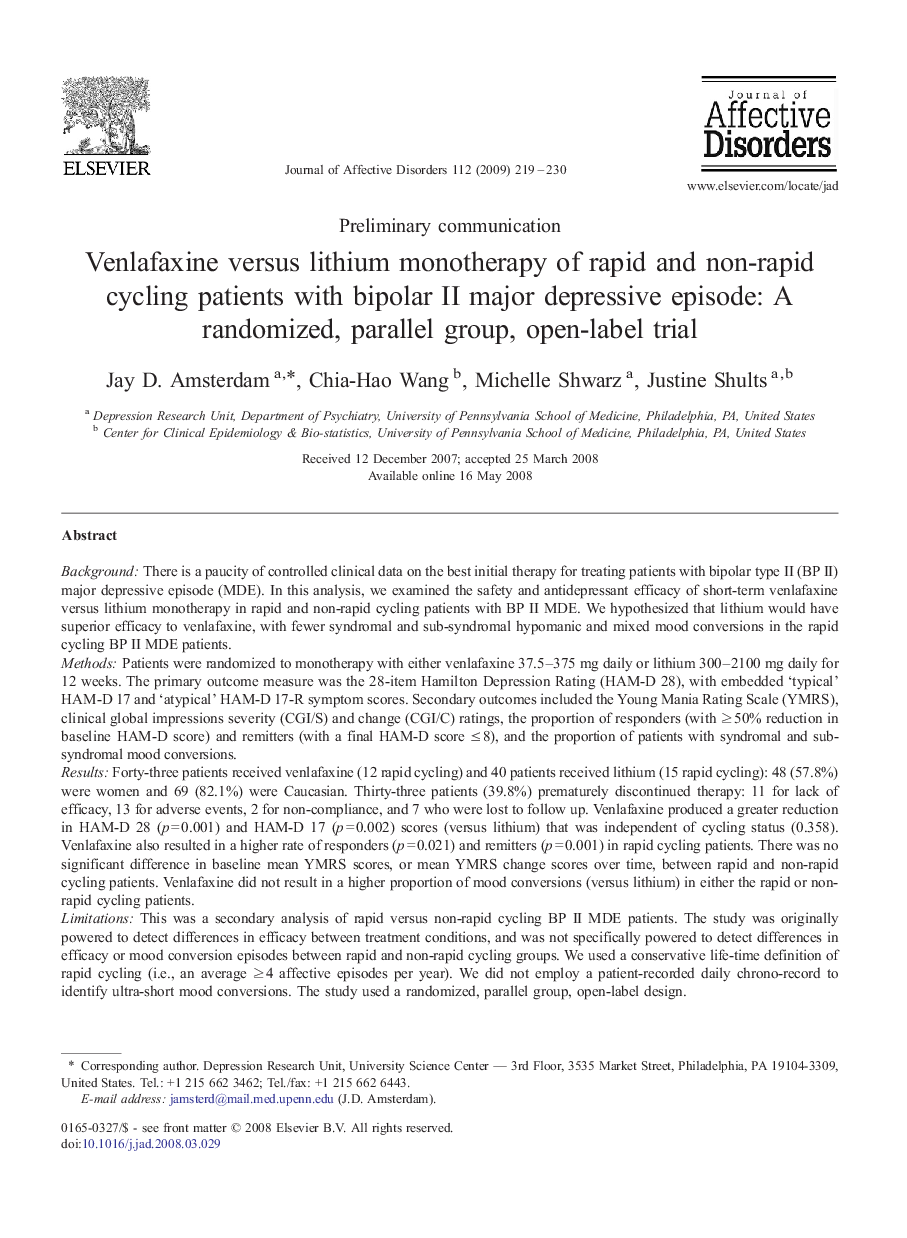| کد مقاله | کد نشریه | سال انتشار | مقاله انگلیسی | نسخه تمام متن |
|---|---|---|---|---|
| 6236677 | 1608208 | 2009 | 12 صفحه PDF | دانلود رایگان |

BackgroundThere is a paucity of controlled clinical data on the best initial therapy for treating patients with bipolar type II (BP II) major depressive episode (MDE). In this analysis, we examined the safety and antidepressant efficacy of short-term venlafaxine versus lithium monotherapy in rapid and non-rapid cycling patients with BP II MDE. We hypothesized that lithium would have superior efficacy to venlafaxine, with fewer syndromal and sub-syndromal hypomanic and mixed mood conversions in the rapid cycling BP II MDE patients.MethodsPatients were randomized to monotherapy with either venlafaxine 37.5-375 mg daily or lithium 300-2100 mg daily for 12 weeks. The primary outcome measure was the 28-item Hamilton Depression Rating (HAM-D 28), with embedded 'typical' HAM-D 17 and 'atypical' HAM-D 17-R symptom scores. Secondary outcomes included the Young Mania Rating Scale (YMRS), clinical global impressions severity (CGI/S) and change (CGI/C) ratings, the proportion of responders (with â¥Â 50% reduction in baseline HAM-D score) and remitters (with a final HAM-D score â¤Â 8), and the proportion of patients with syndromal and sub-syndromal mood conversions.ResultsForty-three patients received venlafaxine (12 rapid cycling) and 40 patients received lithium (15 rapid cycling): 48 (57.8%) were women and 69 (82.1%) were Caucasian. Thirty-three patients (39.8%) prematurely discontinued therapy: 11 for lack of efficacy, 13 for adverse events, 2 for non-compliance, and 7 who were lost to follow up. Venlafaxine produced a greater reduction in HAM-D 28 (p = 0.001) and HAM-D 17 (p = 0.002) scores (versus lithium) that was independent of cycling status (0.358). Venlafaxine also resulted in a higher rate of responders (p = 0.021) and remitters (p = 0.001) in rapid cycling patients. There was no significant difference in baseline mean YMRS scores, or mean YMRS change scores over time, between rapid and non-rapid cycling patients. Venlafaxine did not result in a higher proportion of mood conversions (versus lithium) in either the rapid or non-rapid cycling patients.LimitationsThis was a secondary analysis of rapid versus non-rapid cycling BP II MDE patients. The study was originally powered to detect differences in efficacy between treatment conditions, and was not specifically powered to detect differences in efficacy or mood conversion episodes between rapid and non-rapid cycling groups. We used a conservative life-time definition of rapid cycling (i.e., an average â¥Â 4 affective episodes per year). We did not employ a patient-recorded daily chrono-record to identify ultra-short mood conversions. The study used a randomized, parallel group, open-label design.ConclusionThese observations from this exploratory analysis suggest that venlafaxine monotherapy may be more effective than lithium monotherapy, with a similar mood conversion rate, in rapid and non-rapid cycling patients with BP II MDE. These data support prior observations that venlafaxine monotherapy may be effective initial treatment for BP II MDE.
Journal: Journal of Affective Disorders - Volume 112, Issues 1â3, January 2009, Pages 219-230